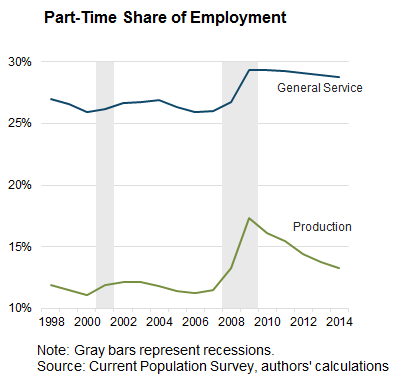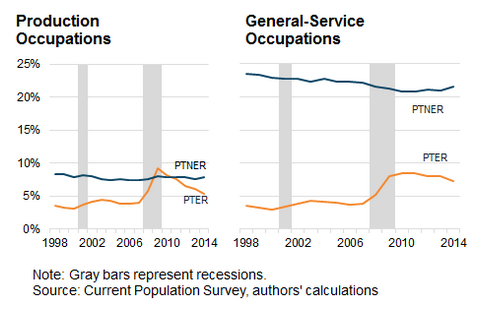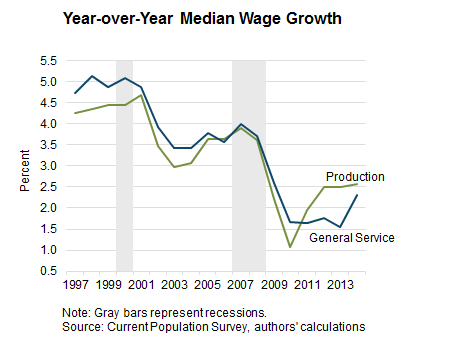The first is that despite gains in 'reshoring' manufacturing jobs the inexorable transition to a service economy remains. That means that the kinds of jobs available present different requirements, different opportunities - and different risks.
Within that larger, structural change, the growth in jobs in the service sector may, in fact, require fewer skills than in recent history. Many of the new jobs are in retail and hospitality where technology and educational demands are less stringent meaning that the pool of those potentially qualified is considerably larger. This, in turn, pushes down wages.
And even in fields with a stronger technological component - coding, customer service, tech support and the like - it is possible to find people skilled enough so that part-time and contract workers may suffice. Further, entire categories may be outsourced to vendors like India's Infosys which relies on the abundance of people willing to do work of this type for more competitive wages.
The result is that downward pressure on compensation and permanent hiring persists. This is especially burdensome for Millennials attempting gain useful experience and a paycheck. Part time work is often all that is available.
The following article suggests that part-time-ism may be a cyclical phenomenon. The problem is that the effects linger long after the cycle has passed. Lower household incomes, fewer incentives to seek higher education and less trust in the workplace send ripples through the economy that impact sales, profits and growth. JL
The Big Picture blog reports:
Compared with 2007, the U.S. labor market now has about 2.5 million more people working part-time and about 2.2 million fewer people working full-time. In this sense, U.S. businesses are more reliant on part-time workers now than in the past.
Compared with 2007, the U.S. labor market now has about 2.5 million more people working part-time and about 2.2 million fewer people working full-time. In this sense, U.S. businesses are more reliant on part-time workers now than in the past.
But that doesn’t necessarily imply we are moving toward a permanently higher share of the workforce engaged in part-time employment. As our colleague Julie Hotchkiss pointed out, almost all jobs created on net from 2010 to 2014 have been full-time. As a result, from 2009 to 2014, the part-time share of employment has declined from 21 percent to 19 percent and is about halfway back to its prerecession level.
But the decline in part-time utilization is not uniform across industries and occupations. In particular, the decline is much slower for occupations that tend to have an above-average share of people working part-time. This portion of the workforce includes general-service jobs such as food preparation, office and administrative support, janitorial services, personal care services, and sales.
The following chart compares the share of part-time employment for these general-service occupations with the share for production-type occupations (such as machine operators, fabricators, construction workers, and truck drivers).
The above chart suggests that if you talk to retailers or restaurateurs, they will say that they always relied pretty heavily on part-time workers. Their utilization increased during the recession, and it really hasn’t changed much since then. But manufacturers or construction firms are more likely to say that part-time work is not that common, and although they did increase their utilization of part-time workers during the recession by quite a lot, things have been gradually returning to normal.
Why is the part-time share of employment declining more slowly in general-service occupations? The economy has been generating full-time general-service jobs at a much slower pace than in the past. Of the approximately 7.6 million full-time jobs created between 2010 and 2014, only about 17 percent have been in general-service occupations, versus about 32 percent of the 7.8 million full-time jobs created between 2003 and 2007. At the current rate of full-time job creation in general-service occupations, it would take more than 10 years for the part-time share of employment in general-service occupations to return to its prerecession average.
From the workers’ perspective, a relevant question is whether these part-time utilization rates are desirable. Some people work part-time and do not currently want or are not available for full-time work (so-called part-time for noneconomic reasons, PTNER). Others are available and want full-time work but are working part-time because of slack business conditions or the unavailability of full-time jobs (so-called part-time for economic reasons, PTER). The following chart shows the share of employment in the general-service and production occupation groupings that is PTER and PTNER.
The chart indicates that most of the movement in the part-time share of employment is coming from people who want full-time work. In both cases, the share of involuntary part-time employment rose during the recession, but for general-service occupations it has been more persistent than for production jobs.
Why has the demand for full-time workers in general-service occupations been more subdued than for other jobs? As the following chart shows, wage growth for these occupations has been quite weak in the past few years, suggesting that employers have not been experiencing much tightness in the supply of workers to fill vacancies for these occupations. Presumably, then, the firms generally find it acceptable to have a greater share of part-time workers than in the past.
The overall share of the workforce employed in part-time jobs is declining and is likely to continue to decline. But the decline is not uniform across industries and occupations. Working part-time has become much more likely in general-service occupations than in the past—and a greater share of those workers are not happy about it.























2 comments:
There is also an absence in full time work in a variety of industries, particularly academia and social welfare. Both go hand in hand to slow community as well as overall societal erosion. I am an adjunct professor and there is simply not a wide market or optimal selections to choose from for full time employment.
Although there are lucrative government positions, they too are very narrow in scope and specialty.
There is also an absence in full time work in a variety of industries, particularly academia and social welfare. Both go hand in hand to slow community as well as overall societal erosion. I am an adjunct professor and there is simply not a wide market or optimal selections to choose from for full time employment.
Although there are lucrative government positions, they too are very narrow in scope and specialty.
Post a Comment